| | -
Not to be confused with Perfect Edition of the Great Mario Character Encyclopedia.  English front cover of the Super Mario Bros. Encyclopedia The Super Mario Bros. Encyclopedia (full title: Super Mario Encyclopedia: The Official Guide to the First 30 Years ), also known as [Nintendo Official Guide Book] Super Mario Bros. Encyclopedia 30th Anniversary 1985–2015 [1] and as Super Mario Bros. Encyclopedia: Nintendo Official Guide Book (Japanese: スーパーマリオブラザーズ百科: 任天堂公式ガイドブック Sūpā Mario Burazāzu Hyakka: Nintendō Kōshiki Gaido Bukku) in Japan, is an encyclopedia that was released exclusively in Japan on October 19, 2015, as part of the celebration of the 30th anniversary of Super Mario Bros. The book covers characters, enemies, power-ups, items, stages, techniques, and graphics from all 17 titles in the main Super Mario series up to Super Mario 3D World,[2] as well as developer interviews, concept art, well-known glitches, and level design explanations.[3] It contains 256 pages. This book was supposed to be translated in English and released in North America and Europe by Dark Horse Comics on June 15, 2017,[4] although preorders for the English translation were canceled in May 2017,[5] and the release date had been moved to October 23, 2018.[6] However, the date was later modified again, this time on October 16.[7] Its German translation was released on October 12, 2017, by Tokyopop,[8] its Spanish translation was released on October 17 by Planeta DeAgostini,[9] its French translation was published on July 4, 2018, by Soleil Productions in the Soleil Manga collection,[10] [11] and its Italian translation was published on November 15, 2018, by Magazzini Salani.[12] [13] Controversy [edit] Following the release of the encyclopedia in English, it was found that one of the translators, Zack Davisson, had taken conjectural and foreign names for characters from fan websites such as the Super Mario Wiki and FANDOM'S MarioWiki.[14] This especially concerns enemies and characters from Super Mario Land 2: 6 Golden Coins, as well as others such as Winged Strollin' Stu (dubbed by the book by its former conjectural name used on the Super Mario Wiki, "Soarin' Stu") and Lumacomète, which is actually the character's French name, used by the Super Mario Wiki due to a lack of an English name.[15] List of English translation errors and typos not from the Super Mario Wiki [edit] This article is under construction. Therefore, please excuse its informal appearance while it is being worked on. We hope to have it completed as soon as possible. | Error | Description |  | On page 11, the book uses edited Japanese artwork from Super Mario Maker that changes the release years to the years that the games were released in the West with the exception of Super Mario Bros.: The Lost Levels. Because of this, the artwork erroneously places Super Mario Bros. 2 in front of Super Mario Land, Super Mario Bros. 3, and Super Mario World despite Super Mario Bros. 2 releasing before those games were released in the West. Super Mario Land is also placed in front of Super Mario Bros. 3 despite Super Mario Land releasing earlier in the West. These errors are fixed on page 13. |  | On page 15, all of the Koopalings use only their first names except for Wendy O. Koopa, who uses her first and middle names, and Ludwig von Koopa, who uses his full name. |  | The English translation states that the POW Block debuted in Super Mario Bros., which is not true as it debuted in Mario Bros., with its Super Mario series debut being Super Mario Bros. 2. |  | On page 25, the English translation erroneously states that the first unmodified American release of Super Mario Bros.: The Lost Levels was the Wii U Virtual Console release in 2014, despite that title actually going to the earlier Wii Virtual Console release in 2007. |  | On page 25, in the paragraph about Super Mario Bros.: The Lost Levels's story, the book claims that "*This text is translated from the Japanese instruction booklet." However, the story includes a reference to Princess Toadstool in the second paragraph, which changes to "Princess Peach" in the third. | 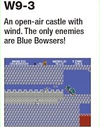 | On page 28, the paragraph about World 9-3 claims that the only enemies in the level are Blue Bowsers, despite there being only one. |  | On page 44, Pipe Cannons are called Gina Cannons. Additionally, the description of it and as the rest of the Super Mario Land enemies use a corruption of the original names from Nintendo Power. |  | On page 45, this is stated under "A Hidden World": "After Mario defeats Tatanga, the Mushroom Castle on the title screen turns into a Mario Castle and he can enter a world with a lot more enemies than before." This is a mistranslation—the word should be "Cursor," not "Castle." |  | On page 51, the Blooper Nanny that fires Bloober babies is called a "Scatter Bloober," which is likely supposed to be "Scattering Bloober." |  | On page 51, the Fiery Walking Piranha is called a "White Piranha," one of Nipper Plant's alternate names. It is referred to using plural pronouns despite only a single Fiery Walking Piranha appearing in the game. |  | On page 64, the book refers to Para-bombs as Para-Bob-ombs and Spike Tops as Red Spike Tops. |  | On page 71, the book incorrectly refers to Wigglers as "Wrigglers" twice before correctly referring to them as Wigglers in the same paragraph. On page 86, the Wiggler is incorrectly called a Wriggler again. |  | On page 71, when the book describes Super Mario World's perfect score, there is an image of a zoom-in of an image of the title screen showing the perfect score of 96. However, the actual image of the title screen that is being zoomed in has three empty save files with no score. | 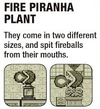 | On page 78, the book incorrectly gives the name "Fire Piranha Plant" to Fire Pakkun Zō. |  | On page 85, Ukkikis are referred to as one character, despite two appearing in Super Mario 64. This is fixed on page 86. |  | In the Super Mario 64 section, the Wiggler is treated as the generic enemy rather than an individual, using plural tense and stating that Wigglers are angry when Mario stomps them. In actuality, the Wiggler is a boss found on Tiny-Huge Island. | 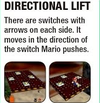 | On page 91, the Work Elevator is incorrectly called a Directional Lift. |  | On page 93, Snowman's Land is incorrectly called "Snowman's Mountain." |  | Bubbles do not appear in the Super Mario 64 section of the book. |  | On pages 118 and 215, lifts are named Flatbed Ferries, a name that has previously been applied only to a specific design of them originating in the Yoshi franchise. | 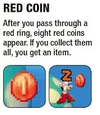 | On page 119, "Red Ring" is not capitalized. |  | On page 128, Jump Guarders and Ring Beamers are called Sentry Garages, a mix of Jump Guarder's Japanese name and "Sentry Beam," and Ring Beams, respectively. |  | On page 128, Montys are incorrectly called Monty Moles. | 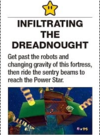 | On page 134, the book incorrectly refers to Eye Beamers as "sentry beams." |  | On pages 145 and 195, in the "enemies" sections for New Super Mario Bros. Wii and New Super Mario Bros. 2, respectively, climbing Koopas are listed as "Climbing Koopa (Green)" despite red climbing Koopas not being listed in those sections and not being in those games. |  | On page 149, the description for W9-3 states: "On this course, Banzai Bills and Bull's-Eye Banzais come one after the other." It should mention Bull's-Eye Bills (or Missile Bills), not Banzai Bills. |  | On page 159, "Digga-Leg" is unhyphenated. |  | On page 186, Little Birds are listed under "Items & Obstacles" despite being neither. |  | + Clocks do not appear in the New Super Mario Bros. 2 section of the book. |  | The purple variants of Dragoneels do not appear in the New Super Mario Bros. U section of the book. |  | On page 226, "Fizzlit" is misspelled as "Fizzlet." On page 159, "Fizzlit" is correctly spelled. |  | On page 236, the first Warp Zone in Super Mario 3D World is erroneously stated to be found in Conkdor Canyon (World 2-1), when in reality it is found in Koopa Troopa Cave (World 1-2). |  | In the Super Mario 3D World section, the screenshot for the ? Box actually depicts a Propeller Box. Also, the icon shown for Captain Toad Makes a Splash is the one for a Mystery House instead of that of a Captain Toad course. |  | On page 245, under DENSETSU NO STAFY 3, it is stated that "Mario appears during a stage." In actuality, this is Wario, which is mentioned correctly in the Japanese version. | List of English translation mistakes and names from the Super Mario Wiki [edit] - Page 44: Genkotsu is known as "Pipe Fist", which was a conjectural title from 2015 to 2018.
- Page 44: Kaitensuru Honō is known as "Roto-disc". The wiki considered them the same thing despite different appearances and Japanese names until a 2018 proposal.
- Page 55: Tornado is known as "Tweester" in the Super Mario Bros. 3 section, which was conflated by the wiki from 2006 to 2017. The same oddity exists in Prima Games' Playing with Power: Nintendo NES Classics.
- Page 63: Fire P-Pakkun is known as "Fire Jumpin' Piranha", which is based on the conjectural "Fire Jumping Piranha" title from 2015 to 2018.
- Pages 75 and 76: With the exception of "Fireball Boy", nearly every enemy name from Super Mario Land 2: 6 Golden Coins is directly lifted from the wiki titles, with macrons removed from romanizations where applicable. This includes "Be" and "Bomubomu", which went under the names B Fly and Bomubomu 1 2 3 in the Japanese version. A similar action was also done to unlocalized enemies from Zelda II: The Adventure of Link in Dark Horse's The Legend of Zelda: Arts & Artifacts. Additionally, "Ant" was a general term and "Bibi" had a name in Nintendo Power, leading both articles to be retitled in 2019.
- Page 78: The Moneybag item is known as "Money Bag", which was an unsourced title from 2007 to 2017.
- Page 85: In the Super Mario 64 section, the "Boss Bass" entry states that it is also known as "Bubba" in the description, which is not mentioned in the Japanese version. With current information, it is Cheep Chomp that is considered to have had the alternate name Bubba, with Boss Bass being the name of a previous, similar iteration of Big Cheep Cheep, although Cheep Chomp is referred to as Boss Bass in Yoshi's Island DS.
- Page 86: The Moneybags enemy is known as "Moneybag" in the Super Mario 64 section only. This was the same mistake on the wiki from 2009 to 2018.
- Page 92: Chair is known as "Killer Chair", which is a translation of an unconfirmed Japanese name styled after Killer Book and Killer Piano. In the book, the latter two are listed among enemies, while the former is listed among items & obstacles. Additionally, it has a completely different name in the Japanese version of the book (Poltergeist).
- Page 92: Keronpa Ball is known as "Kuromame", which is a romanization of an unconfirmed Japanese name used as the wiki title from 2011 to 2017. The Japanese version of the book uses the name Keronpa Ball, which is based on the enemy's appearance as Keronpa in Super Mario 64 DS.
- Page 99: Huge Red Electrokoopa is known as "Electro-Koopa (green)", which was a conjectural title from 2015 to 2019.
- Page 99: Swoopin' Stu is known as "Gooble", which is an unconfirmed name used by the wiki from 2015 to 2019.
- Page 100: Winged Strollin' Stu is known as "Soarin' Stu", which was a conjectural title from 2007 to 2017.
- Page 101: The captain is known as "Pianta Captain", which was a conjectural title from 2007 to 2019.
- Page 101: The Noki grandson is known as "Noki Elder's Grandson", which was a conjectural title from 2010 to 2019.
- Page 105: The electric goop is known as "Electric Graffiti", the Orange Juice Generator is known as "Forcefield", and the burning goop is known as "Lava Graffiti", which were conjectural names in the graffiti article from roughly 2008 to 2019.
- Pages 113 and 117: Kyodai Hanachan is known as "Big Wiggler", which was conflated by the wiki since 2013 until a 2019 proposal.
- Page 119: The face block is known as "Platform Block", which was an unsourced title from 2009 to 2019.
- Page 119: Blue Coin is known as "Silver Coin" in the New Super Mario Bros. section, which was the case in the Silver Coin article until a 2018 proposal.
- Page 126: Comet Tico is known as "Lumacomète", which was a French name used as the article title from 2012 to 2018 that was briefly changed in 2014 and 2015.
- Page 127: Spoing is known as "Bouncing Scuttlebug" in the Super Mario Galaxy section only. This is a remnant of when Spoing and Sprangler were erroneously considered Scuttlebugs by the wiki, which was settled via a 2012 proposal that was mistakenly neglected until 2018.
- Page 127: Skeletal Fish Guard is known as "Fish Bone". The wiki considered them the same thing despite different appearances and Japanese names until a 2018 proposal.
- Page 128: Bat is known as "Swoop" in the Super Mario Galaxy section only. The wiki considered them the same thing despite different appearances and Japanese names (but with basis within internal data) until a 2017 proposal.
- Pages 127 and 159: Mini Wanwan is known as "Chibi Chomp". This is a localization of its alternate Japanese name (Chibi Wanwan) that was used as the wiki title from 2016 to 2017.
- Pages 127 and 159: Fire Pressure is known as "Fire Shooter", which was a conjectural title from 2007 to 2015.
- Pages 128 and 160: Stink Bug Parent is known as "Mandibug Stack", which was a conjectural title from 2013 to 2017.
- Pages 128 and 160: Micro Mecha-Bowser is known as "Mechakoopa" in the Super Mario Galaxy section and "Mini Mechakoopa" in the Super Mario Galaxy 2 section. The wiki considered them the same thing despite different appearances and Japanese names until a 2018 proposal.
- Pages 128 and 161: Petapeta is known as "Starbag", which is the wiki's fan-translation of its apparent German name used as the article title from 2009 to 2017.
- Pages 128 and 161: Jump Beamer is known as "Sentry Beam", with the actual Sentry Beam known by its Japanese name "Laser Pod" in the Super Mario Galaxy section and the name "Mobile Sentry Beam" (on page 160) in the Super Mario Galaxy 2 section. Additionally, Ball Beamer is known as "Bolt Beam" (on page 126) and its description suggests that it is a derivative of the book's Sentry Beam, which is not mentioned in the Japanese version. This is all based on previous versions of the Sentry Beam article from 2010 to 2018, where the conjectural names "Mobile Sentry Beam" and "Bolt Sentry Beam" also appear initially.
- Pages 128 and 161: The names of Spiny Piranha Plant and its sequel derivative, Prickly Piranha Plant, are swapped. This mirrors a mistake on the wiki that went unnoticed from 2010 to 2019, when the Piranha Plant guidance from Super Smash Bros. Ultimate Ver. 2.0.0 used the correct names.
- Page 136: Banandelion is known as "Fling Flower", which was a separate article using a conjectural title from 2011 to 2018.
- Pages 137 and 171: Rubbery bulb is known as "Stretch Plant", which was a conjectural title from 2010 to 2019.
- Pages 137, 171, and 186: Note is known as "Rainbow Note", which was an unsourced title from 2006 to 2019.
- Pages 144 and 146: Hefty Goomba and Big Goomba are respectively known as "Big Goomba" and "Mega Goomba" in the New Super Mario Bros. Wii section only. This is taken from the original wiki articles, which were not fixed until 2018.
- Page 150: Obake Stand is known as "Ghost Vase", which was a conjectural title from 2010 to 2017.
- Pages 151 and 217: The ash is known as "Volcanic Smoke", which was a conjectural title from 2016 to 2018.
- Page 159: The fiery version of Gobblegut fought in the Battle Belt Galaxy is known as "Fire Gobblegut", which was a conjectural title from 2010 to 2016. In another page, it is known as "Fiery Gobblegut", which was a conjectural name that was used from 2016 to 2019.
- Page 160: Golden Gummit is known as "Gold Gummit", which was a conjectural name in the Gummit article from 2013 to 2019.
- Page 161: Tongari is known as "Spiny Hermit", which was a conjectural title from 2010 to 2019.
- Page 161: Bee Eater is known as "Spiny Stretch Plant", which was a conjectural name in the Stretch Plant article from 2010 to 2019.
- Page 161: Flower Mimic is known as "Venus Flower Trap", which was a conjectural title from 2011 to 2019.
- Page 161: Pattan is known as "Whimp", which was a conjectural title from 2010 to 2018 that was briefly changed in 2015.
- Page 166: Sand Bird is known as "Sand Sailer", which was a conjectural title from 2010 to 2020.
- Page 201: Hone Lift is known as "Spine Coaster". The wiki considered them the same thing despite different appearances and Japanese names until a preemptive 2020 split.
- Page 210: Dai Gorō is known as "Mega Grrrol", which was a conjectural title from 2012 to 2017.
- Page 215: Huge Fire Bar is known as "Big Fire Bar", which was a conjectural title from 2015 to 2019.
- Page 217: Arrow lift is known as "Switchback Platform", which was a conjectural title from 2012 to 2018.
- Page 227: The pink Hisstocrat is known as "Queen Hisstocrat", which was a conjectural title from 2013 to 2019.
Gallery [edit] It has been requested that more images be uploaded for this section. Remove this notice only after the additional image(s) have been added. -
-
Second Japanese front cover -
-
-
-
-
-
A page covering enemies from Super Mario Bros.: The Lost Levels -
-
-
-
-
-
-
-
-
-
-
-
-
-
-
-
-
-
-
-
-
-
-
-
-
-
-
-
-
-
-
-
-
-
-
Bullet Bill being fired from a Bill Blaster -
Mario and Luigi surprised -
Peach giving Mario a kiss -
-
-
Mario presenting with a bowtie Names in other languages [edit] | Language | Name | Meaning | | Japanese | スーパーマリオブラザーズ百科: 任天堂公式ガイドブック
Sūpā Mario Burazāzu Hyakka: Nintendō Kōshiki Gaido Bukku | Super Mario Bros. Encyclopedia: Nintendo Official Guidebook | | French (NOE) | Super Mario Encyclopedia : Les 30 premières années | Super Mario Encyclopedia: The first 30 years | | German | Super Mario Bros.-Enzyklopädie (working title)[16]
Super Mario Encyclopedia - Die ersten 30 Jahre | Super Mario Bros. Encyclopedia
Super Mario Encyclopedia: The first 30 years | | Italian | Super Mario Bros. Enciclopedia | Super Mario Bros. Encyclopedia | | Spanish (NOE) | Enciclopedia Super Mario Bros. | Super Mario Bros. Encyclopedia | References [edit] - ^ Last page of the German translation of the Super Mario Bros. Encyclopedia Media:ESMB German page 256.png.
- ^ (September 9, 2015). Nintendo releasing Super Mario encyclopedia in Japan. GoNintendo. Retrieved September 10, 2015.
- ^ Vogel, M. (October 21, 2015). Nintendo of Japan Has Just Published a 30th Anniversary Super Mario Bros. Complete Encyclopedia. Nintendo Life. Retrieved June 18, 2016.
- ^ Brian (February 18, 2017). Super Mario Bros. Encyclopedia coming to North America and Europe in June. Nintendo Everything. Retrieved August 29, 2017.
- ^ Brian (May 6, 2017). Amazon UK cancelling Super Mario Bros. Encyclopedia pre-orders. Nintendo Everything. Retrieved July 2, 2017.
- ^ ECCC 2018: Dark Horse Powers Up Publishing Line with "Super Mario Encyclopedia". Dark Horse. Retrieved February 20, 2018.
- ^ SUPER MARIO ENCYCLOPEDIA: THE OFFICIAL GUIDE TO THE FIRST 30 YEARS HC. Dark Horse. Retrieved May 2, 2018.
- ^ Page of the Super Mario Encyclopedia – Die ersten 30 Jahre on Tokyopop's online shop.
- ^ Page of the Enciclopedia Super Mario Bros 30ª Aniversario on PlanetadeLibros' site.
- ^ Official announcement of the release on Soleil Manga website.
- ^ https://www.amazon.fr/gp/product/2302070046
- ^ [1]
- ^ Twitter post about the release of the Italian translation of the Super Mario Bros. Encyclopedia from the official account of Salani.
- ^ [2]. October 25, 2018.
- ^ It Looks Like The Official Super Mario Encyclopedia Plagiarised A Fan-Made Wiki. Nintendo Life. Retrieved October 25, 2018.
- ^ Tokyopop April-June 2017 programme. Tokyopop. Retrieved July 3, 2018.
External link [edit] | Books | | Magazines | Blip (1983) • Nintendo Power (1988-2012) • Club Nintendo (1989-2002) • Nintendo Dream (1996-Present) • Nintendo Power Advance (2001) | | Chapter books | Super Mario Bros.: Trapped in the Perilous Pit (1989) • Super Mario Bros. 3: Happy Birthday, Princess Toadstool! (1990) • Super Mario Bros. 3: The Secret Bridge (1990) • Nintendo Adventure Books (1991) • Donkey Kong Country (1994) • Donkey Kong Country: Rumble in the Jungle (1995) • Donkey Kong Country: Rescue on Crocodile Isle (1997) • Game Boy Advance (2001) • Mario and the Incredible Rescue (2006) | | Nintendo Adventure Books | Double Trouble (1991) • Leaping Lizards (1991) • Monster Mix-Up (1991) • Koopa Capers (1991) • Pipe Down! (1991) • Doors to Doom (1991) • Dinosaur Dilemma (1991) • Flown the Koopa (1991) • Unjust Desserts (1992) • Brain Drain (1992) | | Activity books | Donkey Kong (1982-1983) • Super Mario Bros. (1989-1993) • Super Mario Bros. Paint 'n' Marker Book (1989/1993) • My Very First Nintendo Game Boy (Donkey Kong Country • Super Mario Adventures) (1997) | | Guidebooks | How to Win at Super Mario Bros. (1987) • Mario Mania (1991) • Perfect Edition of the Great Mario Character Encyclopedia (1994) • How to Draw Donkey Kong & Friends (1997) • How to Draw Nintendo Heroes and Villains (2004) • How to Draw Nintendo Greatest Heroes & Villains (2007) • Super Mario History 1985-2010 (2010) • Super Mario Memorial Book (2015) • Super Mario Bros. Encyclopedia (2015) • Super Mario Odyssey: Kingdom Adventures (2017) • The Art of Super Mario Odyssey (2018) | | Comics and manga | Super Mario (1989-1998) • Nintendo Comics System (1990-1991) • 4koma Manga Kingdom (1991-2002) • Super Mario-kun (1991-Present) • Super Mario Adventures (1992) • 4-koma Gag Battle (1995-2004) • Mario & Donkey Daibōken (1995-1998) • Mario no Bōken Land (1999) • Otenba Peach-hime (1992-1994) • Super Mario 4koma Manga Theater (1993) • Mario vs. Wario (1993) • Mario vs. Wario: The Birthday Bash (1994) • Donkey Kong Jungle Action Special (1995) • Bumm-Badabumm im Urwald (2000) • Donkey Kong in When the Banana Splits (2000) • Wario to Saikyou Tag da Fii! (2003) • Super Mario-kun (Pikkapika Comics) (2004-2006) • Made in Wario (2005) • Go! Go! Mario Kart (2006) • Peach no Daibōken!? (2006-2007) • Waiwai! Wario (2006) • Ore Dayo! Wario Dayo!! (2007-2010) • GO! Ketsu Wario (2008-2011) • Oshiete! Kinopio (2008) • Skylanders: Unexpected Allies (2015) • Super Mario Manga Mania (2020) • Archie Mario comic (canceled) | |




































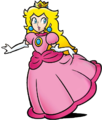





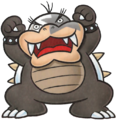

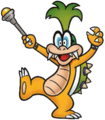
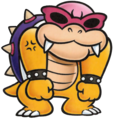

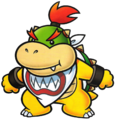
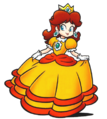










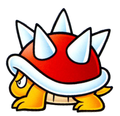
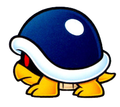




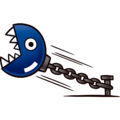
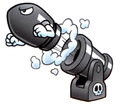
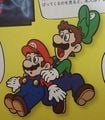





0 Comments